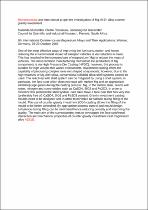 ResearchSpace
ResearchSpace
Microstructural and mechanical properties investigation of Mg-Al-Zn alloy counter gravity investment cast
JavaScript is disabled for your browser. Some features of this site may not work without it.
- ResearchSpace
- →
- Research Publications/Outputs
- →
- Conference Publications
- →
- View Item
| dc.contributor.author |
Mutombo, K

|
|
| dc.contributor.author |
Rossouw, P

|
|
| dc.contributor.author |
Govender, G

|
|
| dc.date.accessioned | 2013-07-02T12:30:27Z | |
| dc.date.available | 2013-07-02T12:30:27Z | |
| dc.date.issued | 2009-10 | |
| dc.identifier.citation | Mutombo K, Rossouw, P and Govender G. 2009. Microstructural and mechanical properties investigation of Mg-Al-Zn alloy counter gravity investment cast. In: 8th International Conference on Magnesium Alloys and Their Applications, Weimar, Germany, 26-29 October 2009 | en_US |
| dc.identifier.uri | http://hdl.handle.net/10204/6850 | |
| dc.description | 8th International Conference on Magnesium Alloys and Their Applications, Weimar, Germany, 26-29 October 2009 | en_US |
| dc.description.abstract | One of the most effective ways of improving the fuel consumption and hence reducing the environmental impact of transport vehicles is via reduction in mass. This has resulted in the increased use of magnesium (Mg) to reduce the mass of vehicles. The most common manufacturing method for the production of Mg components is via High Pressure Die Casting (HPDC), however, this process is suitable for high volume thin walled components. Investment casting offers the capability of producing complex near-net shaped components; however, due to the high reactivity of Mg with silica, conventional colloidal silica shell systems cannot be used. The reactivity with shell system can be mitigated by using a shell system, in particular, the face coat which does not react with molten Mg and an appropriate inhibitor/purge gases during the casting process. Mg, in the molten state, reacts with water, nitrogen and some oxides such as CaSO4, SiO2 and Fe2O3. In order to minimize this problem the shell system used must have a face coat that has very low (preferably free of) CaSO4, SiO2 and Fe2O3 content. Gravity investment casting moulds need to be designed well in order to minimize turbulence during filling of the mould. The use of counter gravity investment (CGI) casting allows the filling of the mould to be better controlled. By appropriate process control and mould design, turbulence during filling can be minimized hence reducing porosity and improving the quality. The main aim of the current project was to investigate the face coat/metal interaction and mechanical properties of counter gravity investment cast magnesium alloy AZ91. | en_US |
| dc.language.iso | en | en_US |
| dc.publisher | Deutsche Gesellschaft fur Materialkunde eV | en_US |
| dc.relation.ispartofseries | Workflow request;2340 | |
| dc.subject | Magnesium alloys | en_US |
| dc.subject | Investment casting | en_US |
| dc.subject | Gravity investment casting | en_US |
| dc.subject | Counter gravity investment (CGI) casting | en_US |
| dc.subject | Face coat | en_US |
| dc.title | Microstructural and mechanical properties investigation of Mg-Al-Zn alloy counter gravity investment cast | en_US |
| dc.type | Conference Presentation | en_US |
| dc.identifier.apacitation | Mutombo, K., Rossouw, P., & Govender, G. (2009). Microstructural and mechanical properties investigation of Mg-Al-Zn alloy counter gravity investment cast. Deutsche Gesellschaft fur Materialkunde eV. http://hdl.handle.net/10204/6850 | en_ZA |
| dc.identifier.chicagocitation | Mutombo, K, P Rossouw, and G Govender. "Microstructural and mechanical properties investigation of Mg-Al-Zn alloy counter gravity investment cast." (2009): http://hdl.handle.net/10204/6850 | en_ZA |
| dc.identifier.vancouvercitation | Mutombo K, Rossouw P, Govender G, Microstructural and mechanical properties investigation of Mg-Al-Zn alloy counter gravity investment cast; Deutsche Gesellschaft fur Materialkunde eV; 2009. http://hdl.handle.net/10204/6850 . | en_ZA |
| dc.identifier.ris | TY - Conference Presentation AU - Mutombo, K AU - Rossouw, P AU - Govender, G AB - One of the most effective ways of improving the fuel consumption and hence reducing the environmental impact of transport vehicles is via reduction in mass. This has resulted in the increased use of magnesium (Mg) to reduce the mass of vehicles. The most common manufacturing method for the production of Mg components is via High Pressure Die Casting (HPDC), however, this process is suitable for high volume thin walled components. Investment casting offers the capability of producing complex near-net shaped components; however, due to the high reactivity of Mg with silica, conventional colloidal silica shell systems cannot be used. The reactivity with shell system can be mitigated by using a shell system, in particular, the face coat which does not react with molten Mg and an appropriate inhibitor/purge gases during the casting process. Mg, in the molten state, reacts with water, nitrogen and some oxides such as CaSO4, SiO2 and Fe2O3. In order to minimize this problem the shell system used must have a face coat that has very low (preferably free of) CaSO4, SiO2 and Fe2O3 content. Gravity investment casting moulds need to be designed well in order to minimize turbulence during filling of the mould. The use of counter gravity investment (CGI) casting allows the filling of the mould to be better controlled. By appropriate process control and mould design, turbulence during filling can be minimized hence reducing porosity and improving the quality. The main aim of the current project was to investigate the face coat/metal interaction and mechanical properties of counter gravity investment cast magnesium alloy AZ91. DA - 2009-10 DB - ResearchSpace DP - CSIR KW - Magnesium alloys KW - Investment casting KW - Gravity investment casting KW - Counter gravity investment (CGI) casting KW - Face coat LK - https://researchspace.csir.co.za PY - 2009 T1 - Microstructural and mechanical properties investigation of Mg-Al-Zn alloy counter gravity investment cast TI - Microstructural and mechanical properties investigation of Mg-Al-Zn alloy counter gravity investment cast UR - http://hdl.handle.net/10204/6850 ER - | en_ZA |





